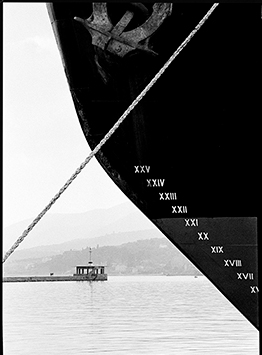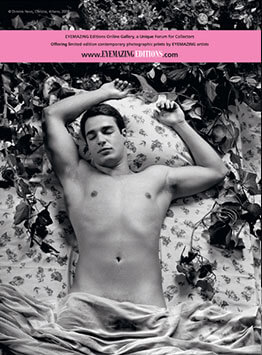by Lauren E. Talalay
Acting Director and Associate Curator, Kelsey Museum University of Michigan.
Kelsey Museum University of Michigan 2002
DIMITRIS YEROS
Sense and Sensibility
Dimitris Yeros stands as a unique figure in contemporary art. Painter, photographer, poet and performance artist, Yeros bridges these worlds with exceptional originality. He is, however, best known as a painter and photographer, creating lyrical and surreal paintings and provocative and richly textured photographs. Although he approaches these two media from different vantage points, one can detect a painterly eye in his photographs and a photographer's sensibility in his paintings. The results are beautifully crafted and arresting images that beckon the viewer to pause and contemplate the human condition.
Yeros's most recent work-in-progress is a book of photographs inspired by the eminent Greek poet Constantine P. Cavafy. Since his death in 1933, Cavafy has emerged as a symbol of the Greek diaspora, inspiring an impressive array of artists, musicians, and writers. With the exception of Duane Michals, however, few contemporary photographers have used Cavafy's evocative verse to create a body of work. Michals's Homage to Cavafy (1978), is a tribute to the poet, who was forced to hide his homosexuality in a society that condemned such behavior. Michals's subtly erotic photographs, which are intended to be "separate and sympathetic," not illustrative of Cavafy's more homoerotic poems, form a perceptive visual narrative on desire, longing, and the brevity of life.
Dimitris Yeros participates in a very different, but equally penetrating, discourse with the great poet. Yeros and Cavafy form a natural but contradictory pair. Both are Greek, tethered to a rich heritage. Both explore the mysteries of human emotion, eroticism, physical beauty, and nostalgia. Yeros, however, was born 15 years after Cavafy's death and inhabits a society poles apart from Cavafy's turn-of-the century culture. The poet lived at the margins of the Greek world, spending most of his adult life in the city of Alexandria, Egypt. Cavafy's works went largely unpublished during his lifetime, celebrated by just a small coterie of admirers. It was only posthumously that he emerged as a towering figure of the modern period. Yeros, on the other hand, is an internationally recognized artist who travels the globe, returning for several months each year to his home away from home the island of Lesbos. His often whimsical and sensuous canvases embrace the surreal, a world far removed from the supremely tangible, often historically based environs of Cavafy's poetry. Yet, for both the world is eternally layered. Both struggle to eloquently capture the vagaries of life that often transcend full understanding. And, both often situate their works within the resonant spheres of the Mediterranean.
Yeros approaches Cavafy's poems with clarity and directness. He takes well-known people, or less often images of common people and landscapes, and contextualizes them within the story, event, or sentiment limned by specific poems. Individuals are carefully matched with selected poems, establishing a dialectic between the person and the verse.
For example, Yeros pairs the poet Richard Howard with Cavafy's poem "Voices." In that brief and economical poem Cavafy muses about the voices of the dead: "Sometimes they speak to us in dreams/ sometimes deep in thought the mind hears them/ And with their sound for a moment return/ sounds for our life's first poetry-/ like music at night, distant, fading away." Richard Howard is himself a poet, known for his erudite poems and exuberant prose. He is also a celebrated translator, who has brought the "voices" of French writers and poets to the English-speaking world. Yeros places Howard within a seeming mausoleum of photographic portraits-floor to ceiling depictions of famous individuals, Howard's friends, and even a picture of Cavafy, whose photo lies just to the left of Howard. The effect is a mosaic of heads surrounding the bespectacled face of Howard. Although the words of the individuals portrayed in the photographs are literally mute-they cannot speak to us-the scene seems to echo with utterances. One can almost hear the "voices" of the people entombed in the photograph.
Equally compelling, although tinged with humor, is the photo of the artist Arman. Arman, an important modern "pop' artist known for innovative sculptures built of sliced, squashed, and burned objects from everyday life, is paired with the poem "Sculptor of Tyana." The sculptor of the poem is an imaginary artist of the Roman Empire who works in Tyana, an ancient city in Cappadocia. The sculptor speaks of his successes and his endeavors, the great gods and goddesses he has lovingly sculpted as well as the eminent Roman senators who have commissioned his work But, he recalls, his favorite work, "wrought with the utmost care and feeling," is
a young Hermes. Yeros's recasts the poem into a witty and modern commentary. Arman sits in a florid robe holding a photograph depicting his own creation of Hermes. Arman's Hermes is not, however, a "classical" rendition but rather an updated version of this winged god, constructed from modern bricolage.
Finally, Yeros creates his own homage to Duane Michals in a photographic "triptych" linked to Cavafy's poem "The Next Table." The poem is set in a "casino" with the writer, an old man, gazing at an adjacent table. At that table sits a young and strikingly handsome male. Looking at the man seated adjacent to him, the older man begins to reminisce about a much earlier encounter with another young lover. He then imagines that he sees, under the clothes of the arresting youth to his side, the body of his erstwhile lover, "the limbs I loved, naked". Yeros's "triptych" unfolds like a narrative-much in the way that Michals uses photographic story-telling-to expose the imaginings of the old man. An older (fully clothed) man glances, first directly, then distantly, then almost secretly at a naked youth lounging at the table next to him. The young man looks dreamily into the distance, oblivious to the stares of his neighbor. The older man is, in fact, Duane Michals and the body of the naked man a reference to the kinds of bodies that filled the pages of Michals's Homage to Cavafy.
Yeros's Cavafy-inspired images offer us both food for thought as well as a moving aesthetic experience. Each photograph is a carefully composed beautifully crisp black and white rendering, filled with details. The images are varied-some celebrate the nude male body, others a chance erotic encounter, still others the interior of a workshop, a sensuous landscape, or a moving view of a country village and its men. The viewer is invited to contemplate the links between poetry and art, to question
why each image was selected, and to consider how the two artistic forms intertwine and resonate. Cavafy once wrote that "Art knows how to shape forms of Beauty, / almost imperceptibly, completing life ". Dimitris Yeros has indeed brought us an art that helps complete life.










